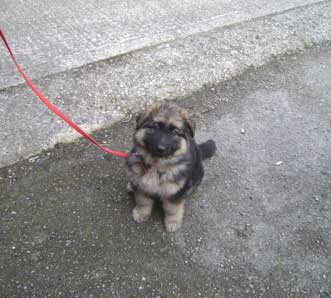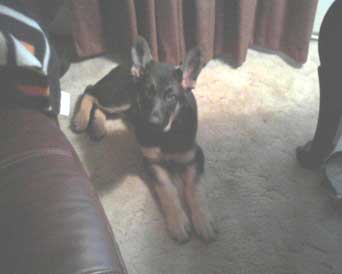Dog Communication
Do you understand dog communication? Let's talk a little bit about some communication that your dog may be having with you that you're probably not even aware of. What does it mean when they growl or bark or howl?
What does it mean if it stares at me or rolls over on it's back when we first meet? You may know some of what it's doing from years of experience with animals but if not, then it's really important that you know what all those dog communication sounds and gestures with you actually means.
So let's talk about nonverbal communication from your dog first. Now your dog will communicate with you in many different ways but you have to remember, say for example, if it's injured, the dog can't talk to you in a language you understand like maybe someone in your family or a friend or coworker. But your dog does speak to you everyday - it's just in a nonverbal form. So, what exactly is your dog trying to say to you?
Well, dogs communicate through their bodily actions and may also communicate with you by barking or growling or other types of verbal inflections. In fact, dogs are masters of nonverbal communication. By watching your body movements they understand much more than most people simply by watching your movements from day to day. But do you understand what your job is trying to say to you?
So let's talk a little bit about what some of this nonverbal dog communication may actually be - and mean. First of all, let's discuss the dog's own body movements - such as its tail. Do you understand what your dog is trying to say to you if it's tail is held between his legs? Basically the dog is trying to tell you that it is threatened and basically this means "I'm scared". And if your dog meets you with a really big wag of its tail then basically that means that it's meeting a friend it hasn't seen in a while and is telling you "I'm so happy to see you."

Now if your dog is wagging its tale only just a small wag basically this is letting you know that the dog is meeting a friend and it's just telling them "hello". But if your God is holding his tail straight out from its body as it meets someone/something, this is basically letting you know that it's challenging an intruder - almost as if it's saying "I may attack" or "I'm ready to take action".
And if it's tail is hanging down and it's not wagging at all this will let you know that the dog may feel that it is in kind of a new and possibly threatening situation to the dog and the dog doesn't exactly know what to do. So basically, in this case, the dog is telling you "I'm not too sure about what to do".
Now concerning the eyes and the ears of a dog, these are very expressive and will often let you know right away, if you understand the language of the dog, what the dog is thinking. They are a great means of dog communication - if you are paying attention.
So what if the dog meets you and it's ears are relaxed. What does that mean? Basically the dog is telling you that he's relaxed, he's comfortable and he does not feel threatened. Now if the dog meets you and suddenly raises his ears straight up, or if you know that the dog has heard a sound, then the dog is reacting - letting you know that the sound is interesting to them, maybe it's something new or something that it doesn't hear very often. So basically this is just the human equivalent of saying "what was that?"
Have you ever met a dog and you see that it's ears are laying flat against his head and they're pulled back against it's head? This is fairly disconcerting and you should know for sure that this means that the dog feels challenged or threatened, or that it feels that it is in a frightening situation.
And this is often what a lot of people misunderstand and sometimes get bitten anyway because they don't understand that the dog's ear carriage in this case is a sure sign that the dog is upset, and the dog dog communication here is telling you that it is maybe even fearful, but ready to bite if necessary.
And if you meet a dog and it avoids eye contact with you all together this is letting you know that it wants to avoid any kind of confrontation with you. But, just the opposite, if you meet a dog and it is directly staring at you on purpose and you're aware of it be aware that the dog is being confrontational with you - even challenging you.
And this is something that you do not want to aggravate, so it's really important to understand that you never want to meet a direct stare with a direct stare of your own as it can lead to something very dangerous. An important form of dog communication to pay very close attention to.

So what about body postures your dog may show you - how do you decipher this kind of dog communication? Now we all understand that the play bow is when the dog is in a playful mood and wants to engage you in playing with it that it will crouch down with his front legs straight out in front of his body with it's butt still up in the air - basically this is the dog trying to encourage you or someone/something else to play with it. But a lot of these other body postures you may not be aware of so well.
So what happens if your dog urinates on something - what does that mean? In most cases if a dog does this on purpose it means "this is mine" or you know that it's marking its territory so is letting you know that it feels that this object belongs to it. Now if your dog has just gone to the bathroom (Poopy) and he scrapes the ground with his front and back feet afterword basically this is just letting everyone know that you should "pay attention to me" or "take note". This particular gesture also lets other dogs know that he was here - another important form of dog communication.
Now if your dog rolls over and exposes his belly this is a very submissive position and basically just means that the dog is letting you be in control. But if you were to meet a dog and it was standing with it's legs very stiff and straight this basically is a very confrontational kind of posture and is letting you know that the dog is ready to fight basically.
So be aware if you meet a dog showing this posture - especially if the dog has his ears back or if he is holding his tail straight out at the same time as it is standing in a stiff legged stance - basically this is a sure sign that the dog is ready to defy whatever it is meeting up with and is ready for confrontation.
So take the time to learn you dog communication signals. If you
are not already aware of what they mean, then good for you, but if not,
do yourself a favor and begin learning them now. It could be one of the
best things that you ever learned.
Return from Dog Communication to German Shepherd Dog Ownership
"A puppy plays with every pup he meets, but an old dog has few associates." -- Josh Billings
Sign up for promotions, news, discounts, and the chance to win prizes for you and your German Shepherd
